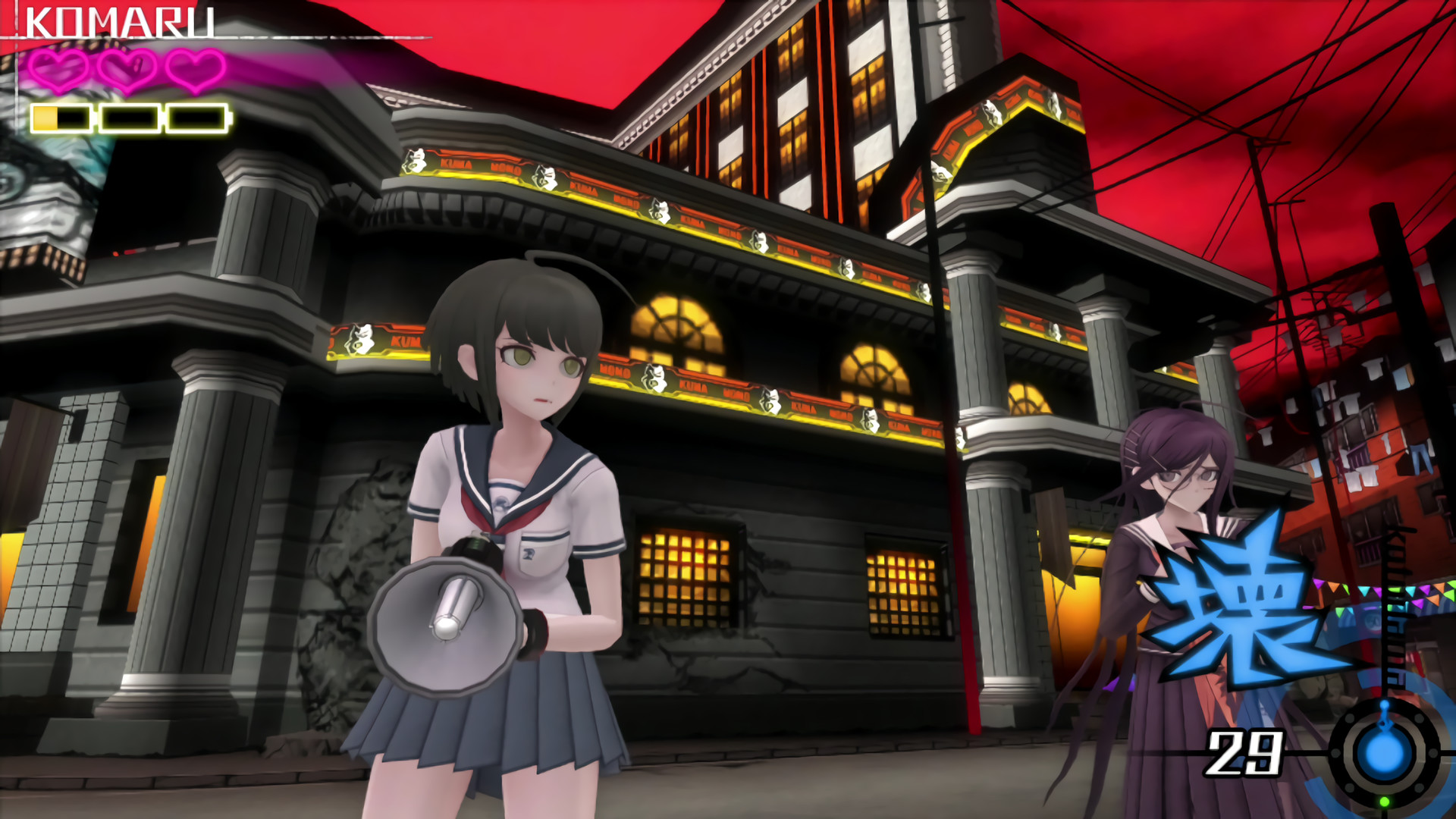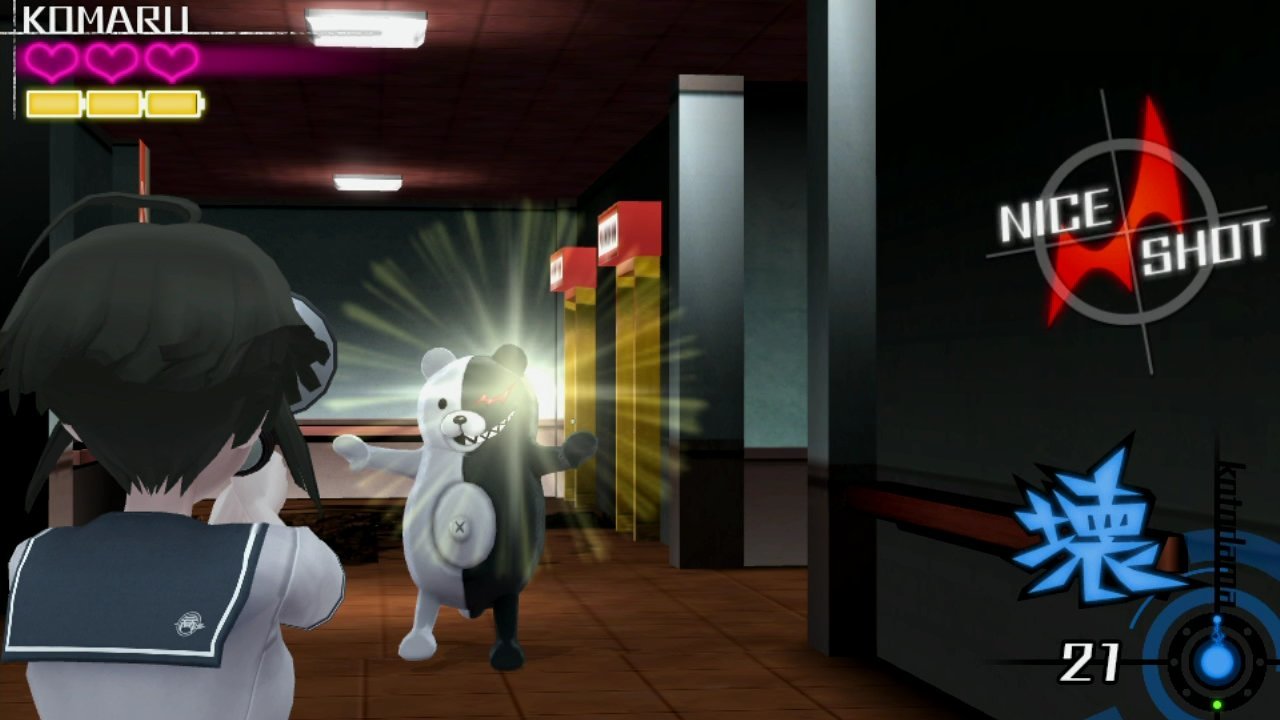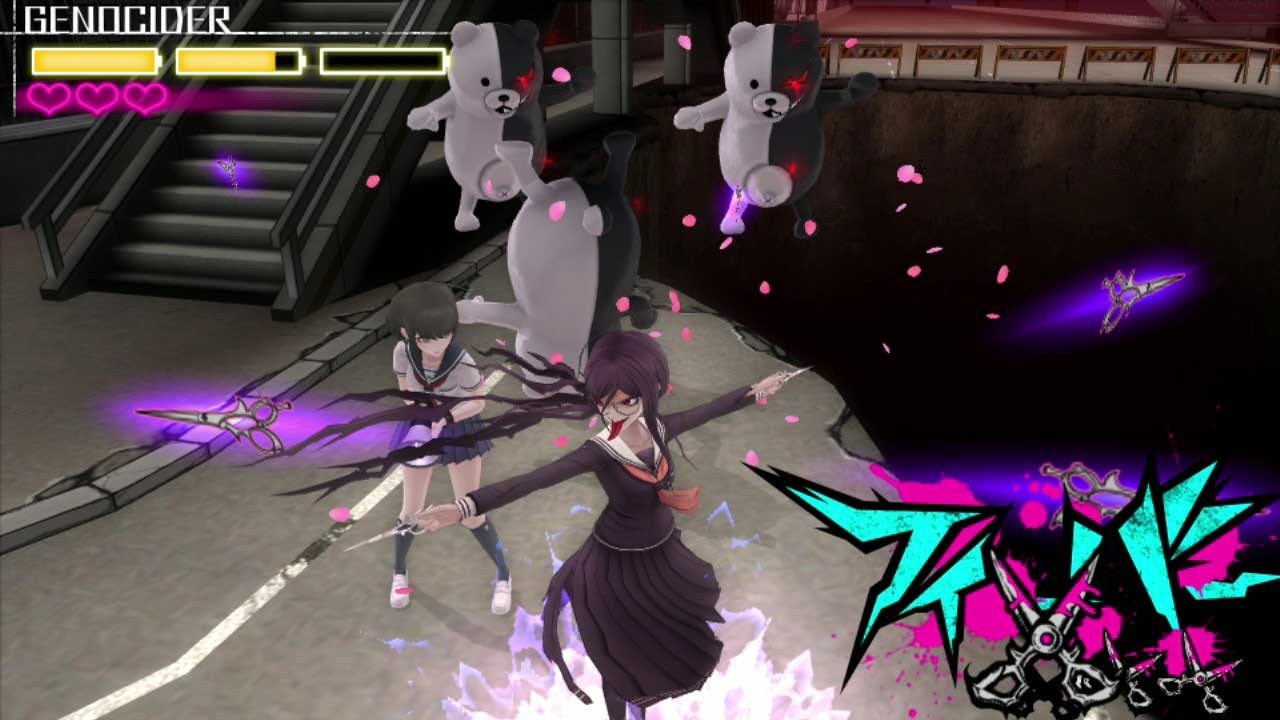Search
[{{{type}}}] {{{reason}}}
{{/data.error.root_cause}}{{{_source.title}}} {{#_source.showPrice}} {{{_source.displayPrice}}} {{/_source.showPrice}}
{{#_source.showLink}} {{/_source.showLink}} {{#_source.showDate}}{{{_source.displayDate}}}
{{/_source.showDate}}{{{_source.description}}}
{{#_source.additionalInfo}}{{#_source.additionalFields}} {{#title}} {{{label}}}: {{{title}}} {{/title}} {{/_source.additionalFields}}
{{/_source.additionalInfo}}- Details
- Category: PlayStation 4
- By Deepfreeze32
- Hits: 8498
Danganronpa Another Episode: Ultra Despair Girls (PS4)

Danganronpa Another Episode: Ultra Despair Girls
Developed by: Spike Chunsoft
Published by: NIS America
Release date: June 27, 2017
Available on: PC, PS4 (Reviewed), PS Vita
Genre: Third-Person Shooter, Visual Novel
Number of players: 1
ESRB Rating: M for Blood, Sexual Content, Strong Language, Violence
Price: $29.99
(Amazon Affiliate Link)
Thanks to NIS America for providing us with a review copy!
Danganronpa Another Episode: Ultra Despair Girls is a bit of an odd duck. Chronologically it takes place between Danganronpa: Trigger Happy Havoc and Danganronpa 2: Goodbye Despair. The main playable characters are the sister of Trigger Happy Havoc’s protagonist and a returning character from Trigger Happy Havoc. However the biggest shift of all is that the game is less of a visual novel mystery story like other Danganronpa games are, and is instead a third-person shooter. Capping this all off, the PS4 version reviewed here is actually a slightly updated port of the original PlayStation Vita version. Sounds kind of wild, right?
Before you get too far into this review, you should know that it is recommended that you play the first two Danganronpa games before playing this one, even though it takes place before the second game. The game spoils major elements of the first game, and includes characters from the second game that could minorly spoil parts of that game. I will try to keep this as spoiler free as possible, but some not-so-minor spoilers of Trigger Happy Havoc are required to talk about the game. Further, the story mostly relies on knowledge of the other Danganronpa games, so if you are considering making this your entry into the series, I would advise against it.
In the game you take control of Komaru Naegi, the younger sister of Makoto Naegi, the protagonist of Trigger Happy Havoc. Komaru is also joined by Makoto’s classmate Toko Fukawa, and her serial killer alter-ego, Genocide Jack. The unlikely duo are trapped in Towa City, which is currently undergoing something of a revolution. Five children, the self-styled Warriors of Hope, have taken over the city with the help of other children in the city. Assisting in this takeover is a robotic army of Monokumas, who mercilessly slaughter all the adults in sight.
So where does the gameplay come in? Early on, Komaru is given a hacking gun to dispatch enemies. The hacking gun is shaped like a bullhorn, and fires projectiles made of some sort of computer code that are capable of disabling the robotic Monokumas. The projectiles use the same name as evidence in other Danganronpa games: Truth Bullets. These Truth Bullets are selected using the D-Pad (or by pressing square to bring up a menu and selecting them from the menu using the D-Pad), and while you only have a few types early on, you get progressively more throughout the game until you have all eight of them.

Strong Points: Great story and characters, Monoku-man challenges are fun.
Weak Points: Awful camera control, subpar controls, technical limitations are apparent.
Moral Warnings: Some sexual references, language, lots of violence, and minor supernatural references.
But the hacking gun is not the only weapon at your disposal. Toko’s Genocide Jack form is invincible and capable of wreaking melee-attack havoc with her scissors, as well as being able to pull off special moves. These special moves use a gauge called the Lust Gauge, and can deal fatal damage to most enemy types. The different types of special moves affect either a single target or up to five, and they deplete the gauge differently. Killing enemies with normal attacks will replenish the gauge. One important thing to note here is that the Genocide Jack form cannot be used indefinitely. Toko uses a stun gun to switch to her Genocide Jack form, and if the batteries run out of the stun gun, you will be forced to take control of Komaru again. On the easiest difficulty the batteries will recharge over time while not in Genocide Jack form, but on higher difficulties you will need to collect battery pickups to recharge the ability to use Genocide Jack.
On that note, items are abundant in this game, but not always in ways that you want. With the exception of a few types of non-combat Truth Bullets, each type of Truth Bullet has its own ammunition type that must be collected as a pickup. In addition, you have health pickups which restore Komaru’s health, and the aforementioned battery pickups for Genocide Jack. All of these types of pickups can be found as drops from enemies, or by using the “Move” Truth Bullet on specific vending machines in the game. Then you have the Monocoins, which you can use to purchase upgrades (more on those in a second). These are only dropped from enemies, given as rewards at the end of each chapter, and occasionally given as rewards for challenges in the game. Next up are skill books, which give you bonuses and abilities provided you have the skill points for them. These are only found on the ground as shining objects. Finally, you have what I will just dub as “readables.” Readables are pickups that do not have a mechanical impact on the game, but provide all sorts of background information about the game world. These include notes left by people, diaries of the Warriors of Hope, and even some books (which will trigger amusing conversations between Toko and Komaru). As with skill books, these are only found as shining objects on the ground.
Progression in Ultra Despair Girls is a bit strange. Komaru and Toko share skill points and active skills, of which some will benefit Toko, some will benefit Komaru, and some will benefit both. The skills cost a certain number of skill points to equip, which is determined by your level. You level up by killing Monokumas, and while it is a functional progression system, it almost feels like it exists to pay tribute to the progression systems in prior Danganronpa games and not to encourage any real sense of progression. I never had to worry about not having enough skill points to equip the skills I had, nor did I ever feel like I had to pick and choose certain skills to optimize my build (outside of omitting a few skills, such as reduced aiming speed and auto-locking to the closest target). Both Komaru and Toko have limited forms of progression that are exclusive to them, and both of them cost Monocoins. Komaru can apply “Bling Bullets” to her Truth Bullets to enhance the effects of them, while Toko has a selection of straightforward upgrades to things like attack speed, battery efficiency, and the size of her Lust Gauge.
I’m sure the most pressing question on your mind right now is “is the game fun?” Well, I don’t wish to be the bearer of bad news, but I personally did not find it to be much fun. The main issue comes down to what I can best describe as “gamefeel.” The game just doesn’t control as smoothly as I would like. The camera is among the worst in third person games I’ve played, and I felt like I was constantly fighting with it. There is no aim sensitivity option in the options menu, and the most control you have is the choice between “Automatic” camera and “Manual” camera. Automatic camera follows the active character, but it only starts to move its position while the character is in motion. So if you do a snap turnaround, the camera will not start to rotate until you start moving in that direction (or you press the re-center camera button). Manual camera is hampered by the ludicrously low aim sensitivity and the inability to change that sensitivity. Selecting the Truth Bullets is also a trying process. The eight truth bullets are bound to the eight possible directions a D-Pad can go. But I found that selecting the bullets on the diagonal positions was tricky business, and the imprecise nature of getting that combination pressed got me killed on more than one occasion.

Higher is better
(10/10 is perfect)
Game Score - 68%
Gameplay - 9/20
Graphics - 9/10
Sound - 10/10
Stability - 3/5
Controls - 3/5
Morality Score - 38%
Violence - 0/10
Language - 3/10
Sexual Content - 3/10
Occult/Supernatural - 7/10
Cultural/Moral/Ethical - 6/10
The one saving grace to the gameplay is a thing called the Monoku-man challenges. These are areas that contain an entry, a sealed exit, and enemies all over the place. The condition is usually just to kill all the enemies to unlock the exit, but sometimes more puzzle elements come into play. For example, one challenge involves using an electric Truth Bullet to shock all of the enemies with one shot. Usually the puzzle elements are optional and only provide a little extra challenge, but the task of figuring out the best way to clear the room was a welcome change from the generic and bland third-person shooter elements that otherwise pepper the game.
So the gameplay is not that great. But what about the story and characters? That’s where Danganronpa games have generally shone in the past. And I am happy to report that the story and characters are indeed great in this game. One of the characters, Haiji Towa, is controversial for being a pedophile. The story starts off slow, but builds to a very compelling conclusion by the end. The characters also start out seeming rather thin, but have unexpected depth to them that really made them interesting over time. In fact, this game has elevated Toko from being an annoyance in Trigger Happy Havoc to one of my favorite characters in the franchise. For that reason alone, I would say this game is worth playing for fans of Danganronpa, but I would urge some caution in paying full price for it, as it is not worth $30 in my opinion.
The art direction is, as with other Danganronpa games, bright and vivid. Despite being a third-person shooter, the game retains some of the visual novel roots of Danganronpa games. Sections of the game are done with sprites and text boxes, and they retain the signature style and attention to detail that Danganronpa is known for. Other parts of the story are done with anime-style cutscenes, which are also of high quality. The remaining story cutscenes and the main game consists of 3D models. The transition into 3D works reasonably well, with most characters retaining the same style that their sprites have. If I have one complaint to level against the 3D work in this game, it is that the shaders do not quite create the same style that the 2D work has, and it looks a little bit dated which is perhaps due to the game originating on the Vita.
Masafumi Takada composed the score for this game, and once again, he delivers a fantastic and rousing soundtrack. A few returning themes are here, and the new songs are just great. The new songs vary in style from jazzy lounge tracks to more upbeat and guitar driven tracks. The voice acting in the game is also pretty solid, with the characters who return from other Danganronpa games retaining their voice actors. I played primarily in the Japanese dub, which has excellent performances by most characters.
On that note, setting Japanese voices is a surprisingly obtuse endeavor, requiring you to pick it from a somewhat non-obvious triangle button prompt on the difficulty select screen. Previous and future Danganronpa games had an option that was a separate screen from the difficulty select. Further, selecting Japanese means that the title card and text in the movies is in Japanese, which is a little bit annoying compared with prior DR games. Some of this text is translated, some of it is not. The most egregious example of not translating the text is in the opening title cutscene, which contains character names rendered only in Japanese. Lastly, the only way to get any subtitles during the cutscenes is to play with Japanese voices, as the game does not have a subtitles option of any sort.

The game is not without some technical limitations that serve to hamper the experience. Load times are just often long enough to frustrate, and the amount of loading screens encountered in the game definitely betrays the fact that this was a Vita port. The game loads for different sections of the map, and in between every cutscene segment. Finally, I encountered an actual crash in the game while fighting the final boss in the game. I was attempting to use a special move with Genocide Jack, and when the attack began, the game crashed. When I restarted the game, I had to load from my previous save game, which was about half an hour prior and involved skipping several cutscenes and making dialog choices. I decided not to attempt the special move again during the final boss, and was able to complete it without issues.
It wouldn’t be a Danganronpa game if it wasn’t full of some objectionable content, and there’s a lot to talk about here. Language is relatively standard fare for Danganronpa. Toko says the S-word several times, a few other characters drop the F-word a couple of times. Both B-words are used, as well as A** and D*** several times each. Drug content is super sparse in this game; the only thing that stood out to me was one character who is seen holding a cigar in their mouth. The game has some interesting ethical moral content, in that children kill their parents, but they are brainwashed into doing it. The game also talks a lot about the importance of hope, and the main character makes a difficult choice which is a bit sacrificial for her, but is intended to prevent a lot of suffering for other people.
Sexual content is notably lighter here than in Danganronpa V3, but there is still a lot to talk about. Toko fantasizes about being intimate with someone, though these fantasies are drawn with a super exaggerated cartoon style and contain a note in the upper left corner of the screen saying “Attention: Toko’s Fantasy.” No nudity is shown. One character makes reference to wieners and sends Toko into a rant about how it's indecent to say that while saying it many times. One minigame involves Komaru being groped by mechanical arms, and you have to fight off the arms to progress. The instigator even makes a remark about how this is the opposite of child porn, so it's ok for a video game. A female character falls in such a position that her skirt is lifted, allowing us to see her panties. She also flashes her panties at the camera a few times, usually to the disgust of the main characters. One of the Warriors of Hope, a former child actress, is implied to have been sexually assaulted by people she worked with while growing up. Toko at one point puns Komaru’s name with a term for semen. Some fights involve either Komaru or the person she is fighting getting slowly stripped down to their underwear as the fight wears on.
Supernatural content is not a super common thing in Danganronpa, but there is some to discuss here. Komaru makes references to seeing ghosts, and at one point apparently gets possessed by a ghost who reveals information to her, and she worries that she will be cursed by the ghost. Toko thinks she is hallucinating, but the information later turns out to be accurate. Another character creates a magical circle for use in a ritual, but the exact nature of the ritual is not revealed.
I suppose you can’t have Danganronpa without lots of violent content. Violence here includes copious amounts of blood, shots of some people getting hanged, crucified, impaled, blown up, torn to shreds, and more. One scene involves a torture chamber, though not much is seen beyond blood on the ground around the torture instruments. Another scene shows a hypothetical situation where heads of children are blown up by masks they are wearing. A late-game scene involves the characters needing to use the head of a corpse to open a retinal-scan door, though the head itself is not shown.
Ultra Despair Girls is not really what I would call a “good” game. The combat systems are wonky, and the camera control is downright awful. The story and characters are well worth playing the game for, but I have a hard time recommending this game on that basis to anyone but the most dedicated of Danganronpa fans because the story hinges on knowledge of other Danganronpa games. When you take into account the technical issues, I have a hard time even recommending it to fans at the list price of $30. If you can find it a lesser price, and are willing to look past the objectionable content, then the story and characters do tell a compelling tale in spite of the gameplay.








